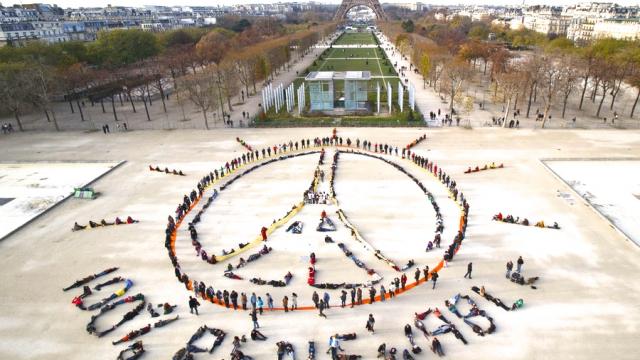
Some people are relaxing after organizing a really powerful redlines action
Some people are still trying to figure out what this climate agreement will really get us.
Some people are gearing up to keep on fighting. Because that’s what we need.
Here’s a rough (unofficial) overview of some different parts of the agreement:
– Temperature Goal: One of the biggest battles at COP21 has been the goal of how much we let our planet heat up. Vulnerable countries fought hard for the goal of 1.5°C — one that’s more in line with justice and science. This wasn’t even on the table to begin with. It’s now in the agreement (well sort of), and even a recognition of it is great. Much is owed to island nations and climate justice groups
Here’s what the text does say:
“Holding the increase in the global average temperature to well below 2 °C above pre-industrial levels and to pursue efforts to limit the temperature increase to 1.5 °C above pre-industrial levels, recognizing that this would significantly reduce the risks and impacts of climate change.”
2°C will be the binding part though, so getting countries to really aim for 1.5°C will require a lot of pressure in the years to come. If we aim for 1.5°C it means nations get to stay above water. It means more communities are protected. It means more people get to survive. Read more about 1.5°C and what that means here.
Whether it’s 2 or 1.5C – what’s clear is we have to move to get off of fossil fuels fast.
– Indigenous Rights, human rights, women’s rights: Have been moved to sections of the text where they aren’t legally protected or operationalized. Read a joint response from indigenous groups about the talks.
– Pledges to Cut Emissions: This is stuff we already knew coming into the talks. Countries submitted before-hand their plans to curb or cut emissions, and it will only limit temperature increase by (around) 2.7 – 3.7°C. That’s down from the 5°C or so represented from business as usual. Progress, but not nearly enough to result in a livable climate. There’s a huge amount of work to be done.
– Setting the long term goal to get off fossil fuels: What we wanted was a clear timeline for when we transition off of fossil fuels. We and others pushed hard to make 2050 the goal for when the world would be 100% off of fossil fuels.
The final text created something that at first glance inserted some weird things:
“Parties aim to reach global peaking of greenhouse gas emissions as soon as possible, recognizing that peaking will take longer for developing country Parties, and to undertake rapid reductions thereafter in accordance with best available science, so as to achieve a balance between anthropogenic emissions by sources and removals by sinks of greenhouse gases in the second half of this century.”
People are still figuring out what “a balance between anthropogenic emissions by sources and removals by sinks of greenhouse gases” actually means. Experts are saying it means getting to “net zero emissions” between 2050 and 2100, which could open the door to risky geo-engineering schemes. If we want to have a good chance of keeping global warming below 2°C (staying below 1.5°C or getting back there quickly would require bolder action), then we clearly need full decarbonization by 2050. The safest way to protect our climate is to break the power that the fossil fuel industry holds on our political and energy systems.
– 5 year review mechanism: We won’t always have Paris. One of the good things about this agreement is the 5 year review mechanism. Right now the contributions from each country will not bring us a safe world, not even close. But now this agreement would “force countries to come back to the table every five years to review their emissions reduction targets and make new, more ambitious cuts.”
This is often known as the ‘ratchet mechanism’ and could push countries to keep on stepping up. It’s one thing that could help cut the gap between policy and science. Countries have been asked to start reviewing their pledges in 2018 so that new commitments could be ready to go by 2020.
– Supporting most vulnerable: Will the nations most impacted by climate change get the support they need? Not nearly enough.
“Ethiopian activist Azeb Girmai, speaking for LDC Watch, which keeps an eye on the least developed countries in Africa and elsewhere, described it as “the saddest day for all the poor people in the world facing loss and damage day-in and day-out” while their representatives in Paris were “bullied” by rich countries.” read more
Also good to follow @AsianPeoplesMvt on Twitter for some good response.
– Holding countries accountable: What will happen if countries don’t fulfill their promises and pledges? Well nothing really. There are no review mechanisms if countries do not comply.
3 WAYS TO SHOW YOUR SUPPORT
- Log in to post comments











